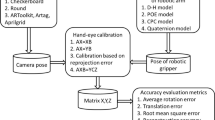Abstract
Gaze control requires the coordination of movements of both eyes and head to fixate on a target. Using our biologically constrained architecture for gaze control we show how the relationships between the coupled sensorimotor systems can be learnt autonomously from scratch, allowing for adaptation as the system grows or changes. Infant studies suggest developmental learning strategies, which can be applied to sensorimotor learning in humanoid robots. We examine environmental constraints for the learning of eye and head coupled mappings, and give results from implementations on an iCub robot. The results show the impact of these constraints and how they can be overcome to benefit the development of fast, cumulative, on-line learning of coupled sensorimotor systems.
Similar content being viewed by others
References
M. Asada, K. Hosoda, Y. Kuniyoshi, H. Ishiguro, T. Inui, Y. Yoshikawa, M. Ogino, and C. Yoshida, “Cognitive developmental robotics: A survey”, IEEE Transactions on Autonomous Mental Development, vol. 1, no. 1, pp. 12–34, 2009.
J. Piaget, The Child’s Conception of the World, Paladin, London, 1973.
R. Pfeifer and C. Scheier, “Sensory-motor coordination: the metaphor and beyond”, Robotics and Autonomous Systems, vol. 20, no. 2, pp. 157–178, 1997.
L. Smith and M. Gasser, “The development of embodied cognition: Six lessons from babies”, Artificial Life, vol. 11, no. 1–2, pp. 13–29, 2005.
D. L. Gallahue, Understanding Motor Development in Children, John Wiley, NY, 1982.
R. M. Angulo-Kinzler, B. Ulrich, and E. Thelen, “Three-month-old infants can select specific leg motor solutions.”, Motor Control, vol. 6, no. 1, pp. 52–68, 2002.
Darwin Muir and Jeffery Field, “Newborn infants orient to sounds”, Child Development, vol. 50, pp. 431–436, 1979.
J. F. Rosenblith, In the Beginning: Development from Conception to Age Two, Sage Publications, Newbury Park, CA, second edition, 1992.
C. M. Harris, M. Jacobs, F. Shawkat, and D. Taylor, “The development of saccadic accuracy in the first seven months”, Clinical Vision Sciences, vol. 8, no. 1, pp. 85–96, 1993.
R. Griffiths, The abilities of babies, University of London Press, London, 1954.
M. D. Sheridan, From Birth to Five Years, NFER Publishing, Windsor, USA, 1973.
D. Maurer and C. Maurer, The World of the Newborn, Basic Books, New York, 1988.
A. E. Milewski, “Infants’ discrimination of internal and external pattern elements”, Experimental Child Psychology, vol. 22, pp. 229–246, 1976.
R. N. Aslin, “Visual and auditory development in infancy”, in Handbook of Infancy, J. D. Osofsky, Ed. John Wiley, New York, second edition, 1987.
J. Oates, C. Wood, and A. Grayson, Psychological Development and Early Childhood, Blackwell Publishing, Malden, MA, 2005.
E. Tronick, “Stimulus control and the growth of the infant’s effective visual field”, Perception & Psychophysics, vol. 11, no. 5, pp. 373–376, 1972.
M. R. Fiorentino, A Basis for Sensorimotor Development, Normal and Abnormal: The Influence of Primitive, Postural Reflexes on the Development and Distribution of Tone, Charles C Thomas, Springfield, Ill, 1981.
F. Goodkin, “The development of mature patterns of head eye coordination in the human infant”, Early Human Development, vol. 4, pp. 373–386, 1980.
J. Law, M. Lee, M. Hülse, and A. Tomassetti, “The infant development timeline and its application to robot shaping”, Adaptive Behaviour, vol. 19, pp. 335–358, 2011.
G. Metta, G. Sandini, D. Vernon, L. Natale, and F Nori, “The icub humanoid robot: an open platform for research in embodied cognition”, in Proceedings of the 8th Workshop on Performance Metrics for Intelligent Systems, Washington DC, USA, 2008, ACM, pp. 50–56.
J. Law, M. Lee, and M. Huelse, “Infant development sequences for shaping sensorimotor learning in humanoid robots”, in Proc. 10th Int. Conf. on Epigenetic Robotics, 2010, pp. 65–72.
M. H. Lee, Q. Meng, and F. Chao, “Staged competence learning in developmental robotics”, Adaptive Behaviour, vol. 15, no. 3, pp. 241–255, 2007.
A. Needham, T. Barrett, and K. Peterman, “A pick-me-up for infants’ exploratory skills: Early simulated experiences reaching for objects using ‘sticky mittens’ enhances young infants’ object exploration skills”, Infant Behavior and Development, vol. 25, no. 3, pp. 279–295, 2002.
J. Law, P. Shaw, and M. Lee, “A biologically constrained architecture for developmental learning of eye-head gaze control on a humanoid robot”, Autonomous Robots, 2013, Accepted.
M. Hülse and M. Lee, “Adaptation of coupled sensorimotor mappings: An investigation towards developmental learning of humanoids”, in SAB 2010, LNAI 6226, S. Doncieux, Ed. 2010, pp. 468–477, Springer.
R. A. Marino, C. K. Rodgers, R. Levy, and D. P. Munoz, “Spatial relationships of visuomotor transformations in the superior colliculus map”, Journal of Neurophysiology, vol. 100, no. 5, pp. 2564–2576, 2008.
E. M. Klier, H. Wang, and J. D. Crawford, “The superior colliculus encodes gaze commands in retinal coordinates.”, Nat Neurosci, vol. 4, no. 6, pp. 627–32, 2001.
N. J. Gandhi and H. A. Katnani, “Motor functions of the superior colliculus”, Annual Review of Neuroscience, vol. 34, no. 1, pp. 205–231, 2011.
H. H. L. M. Goossens and A. J. van Opstal, “Human eye-head coordination in two dimensions under different sensorimotor conditions”, Experimental Brain Research, vol. 114, pp. 542–560, 1997.
X. Wang and J. Jin, “A quantitive analysis for decomposing visual signal of the gaze displacement”, in Proceedings of the Pan-Sydney area workshop on Visual information processing — Volume 11 (VIP’ 01), David Dagan Feng, Jesse Jin, Peter Eades, and Hong Yan, Eds., Darlinghurst, Australia, 2001, vol. 11, pp. 153–159, Australian Computer Society, Inc.
D. Guitton and M. Volle, “Gaze control in humans: eye-head coordination during orienting movements to targets within and beyond the oculomotor range”, Journal of Neurophysiology, vol. 58, no. 3, pp. 427–459, 1987.
E. Freedman, “Coordination of the eyes and head during visual orienting”, Experimental Brain Research, vol. 190, no. 4, pp. 369–387, 2008.
Author information
Authors and Affiliations
Corresponding author
About this article
Cite this article
Shaw, P., Law, J. & Lee, M. An evaluation of environmental constraints for biologically constrained development of gaze control on an iCub robot. Paladyn 3, 147–155 (2012). https://doi.org/10.2478/s13230-013-0103-y
Received:
Accepted:
Published:
Issue Date:
DOI: https://doi.org/10.2478/s13230-013-0103-y




